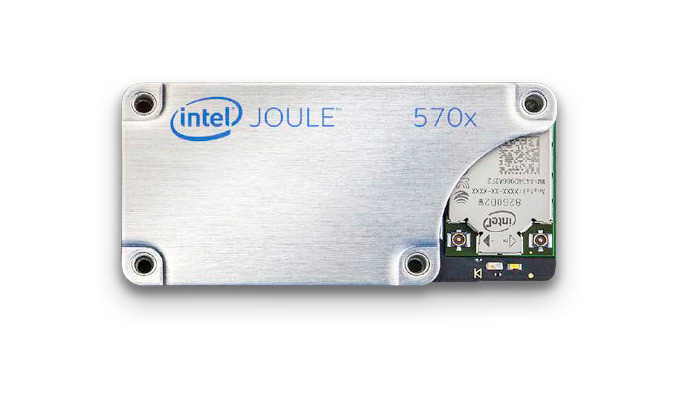Intel Unveils Joule: A High-Performance Atom-Powered IoT Module & Maker Kit
by Ryan Smith on August 17, 2016 4:30 AM EST
Today at Intel’s annual Developer Forum, the hardware manufacturer announced the latest in their Internet of Things-focused product kits: Joule. Based around Intel’s canceled-but-not-quite Broxton Atom processor, Joule is designed to further augment Intel’s existing lineup of kits by offering a much higher performance part based on the latest generations of the company’s technologies.
Back in 2013 Intel announced Galileo, the first of what has become a collection of IoT kits/platforms for hardware developers. Galileo and its compatriots Edison and Curie turned out to be solid hits for the company – even with competing kits already on the market – driving a big part of Intel’s overall IoT growth in recent years. The System on Module boards proved popular with tinkers and product developers alike who needed small systems for everything from small prototypes to a commercial off the shelf boards.
| Intel IoT Kits | |||||
| Joule 570X | Joule 550X | Edison | |||
| SoC | Intel Atom "Broxton-M" T5700 |
Intel Atom "Broxton-M" T5500 |
Intel Atom "Tangier" Z34xx |
||
| CPU | 4x Goldmont @ 1.7GHz, Turbo to 2.4GHz | 4x Goldmont @ 1.5GHz | 2x Silvermont @ 500MHz 1x Quark @ 100MHz |
||
| GPU | Intel Gen9 | Intel Gen9 | N/A | ||
| RAM | 4GB LPDDR4 | 3GB LPDDR4 | 1GB LPDDR3 | ||
| Storage | 16GB eMMC | 8GB eMMC | 4GB eMMC | ||
| Wireless | 802.11ac w/MIMO + BT 4.1 | 802.11n + BT 4.0 | |||
| I/O | UART + GPIO + I2C + MIPI CSI + MIPI DSI + USB 3.0 | SD + UART + SPI + GPIO + USB 2.0 OTG | |||
| Dimentions | 48 x 24 x 5 mm | 35.5 x 25 x 3.9 mm | |||
Joule then extends Intel’s presence in this market by offering a higher performing part in their IoT portfolio. Whereas the previous top-tier Edison board used a combination of Atom Silvermont and Quark CPU cores and paired this up with a respectable amount of RAM, NAND, and I/O options, Joule goes much further. The SoC at the heart of the board is Intel’s Broxton-M, which although was canceled for consumer devices, as we can now see will instead be making a home for itself within Intel’s IoT product family.
Intel is offering two different versions of the Joule board. Both use the same SoC, but they vary in clockspeeds and memory. The more powerful of the two, Joule 570X, uses what Intel is calling a Atom T5700, which is a quad core Goldmont Atom configuration with a base clock of 1.7GHz and can turbo to 2.4GHz. This in turn is paired with 4GB of LPDDR4 memory and a 16GB eMMC NAND module for non-volatile storage. Meanwhile the Joule 550X drops the quad core Atom to 1.5GHz with no turbo, and features 3GB of LPDDR4 memory along with 8GB of NAND.
Both Joule boards also feature the same I/O connectivity. On the wireless side, this is composed of a radio supporting Bluetooth 4.1 and 802.11ac (MIMO is listed supported, so I’m wagering this is a 2 spatial stream solution). And on the wired side, USB 3.0 is supported, along with the vast collection of GPIOs, UARTs, and MIPI’s camera (CSI) and display (DSI) interfaces.
The Joule module itself is said to only be a bit larger than the Edison module – which was usually measured relative to a postage stamp – and in the brief glimpse of the module we got when Brian Krzanich held it out on stage, I’d say we’re looking at something not too much bigger than a stick of gum (or perhaps the old Sony memory stick). Intel hasn’t released the full documentation for the kit yet, so we don’t have power consumption information available, but given the higher performance goals for the kit (and the quad Goldmont CPU cores), it’s a fair bet that it’s going to be higher than Edison.
As you might expect from the specifications, Intel is aiming Joule at a higher performance class of use cases. Ultimately as a maker kit it’s a bit of an “if you build it” situation – it’s up to developers to figure out what to do with it – but Intel sees it as being useful for drones, AR/VR, robotics, and for the first time in one of their IoT products, computer vision. While we don’t have a ton of hard details on the underlying iGPU, it is powerful enough for certain CV tasks, and it supports both 4K video capture and display. It also supports Intel’s RealSense camera, giving developers the option of using the underlying depth sensing capabilities for improved vision/analysis.
Finally, on the software side of matters, the Joule will support a few different OSes. The boards will default to a new Linux distribution specifically designed for the hardware that Intel is calling Reference Linux OS for IoT, and Cannonical’s “Snappy” Ubuntu Core is also supported. Meanwhile Microsoft’s Windows 10 IoT Core is also supported for developers who need Windows interoperability.
Wrapping things up, along with today’s announcement, Intel has already begun selling one of the Joule SKUs, with the others to follow. The Joule 570X development kit, which includes the Joule module, carrier board, WiFi antennas, and other components is on sale today at IDF for $369, and will be available through Intel’s partners next month. At that price it’s fair to say that Intel is not aiming to have Joule compete with more mainstream kits – or even their own Edison kit – but rather at the more upscale kits such as the (even more expensive) NVIDIA Jetson TX1, which is a much tighter market in terms of the number of competitors.
Meanwhile the lower-end 550X development kit and the stand-alone Joule modules are scheduled for release in Q4. Pricing for those products has not yet been disclosed, though given the intent for Joule to be used in mass production devices, it’ll be interesting to see what Intel prices the stand-alone modules at.
Source: Intel












60 Comments
View All Comments
beginner99 - Wednesday, August 17, 2016 - link
Can anyone explain to be the point if cancelling this for tablets when it is ready and in production? is it price only? As at that price it would have 0 chance to compete in tablet space.Meteor2 - Wednesday, August 17, 2016 - link
Well you just answered your own question lol. There's no profit for Intel to compete with cheap ARM and Core M from fights with A9X at high-margin prices.rhysiam - Wednesday, August 17, 2016 - link
I suspect it's also the consistent failure of Intel to secure any significant design wins. From a performance point of view, the Atoms weren't too bad, but Intel couldn't convince partners to design and ship them in any half-decent products. It's not dissimilar to AMD's struggles in the laptop space. They actually offer some reasonably compelling mobile APUs, but trying to find a shipping laptop with an APU that you could actually recommend (decent display and build quality, SSD) is almost impossible, or at least was the last time I went looking. You can have the best CPU/SOC on the market, but if it's not shipping in any devices that people actually want to buy then no ones going to buy it.atirado - Wednesday, August 17, 2016 - link
At first, I was surprised about the price because compared to other small form factors it looks expensive. However, if you look at the specs in Ark this thing actually packs quite a punch and it has some nice features like a TPM. For example, you would not have to spend on storage, wifi, bluetooth, usb expansions. You get all these and performance ones at that. Try buying just as many Raspberry Pies and you still will not get the same performance.So yes, IMO, it is well geared to IoT applications in which security is good to have.
psychobriggsy - Wednesday, August 17, 2016 - link
Isn't the standard for IoT security ARM Trustzone though?And sure, this is better specced than a Pi, but the Pi is 1/10th the cost. There are other ARM SBCs that have it all as well for a reasonable price too.
DanNeely - Wednesday, August 17, 2016 - link
I always thought the standard for Io(pwnd)T was unencrypted HTTP and/or software that's several years out of date when shipped for a large number of release day exploits and which never is patched after release to maximize the number of new bugs available over time.name99 - Thursday, August 18, 2016 - link
It's not clear that it has to be that way (though it probably will be on Android).Part of the way Apple has designed HomeKit is to force a certain minimum level of security on vendors (and now, with iOS 10, to force a certain minimum level of UI functionality; I'm guessing the changes in iOS 10 also provide support to make it maximally easy for vendors to apply updates, with Apple doing all the hassle stuff like UI and version checking --- vendor just dumps a new firmware binary on some Apple server).
Of course it IS a problem, but it's not like this is new. Printers, hard drives, bluetooth peripherals, routers. They all have firmware, and they've all suffered from terrible support for updates, ranging from flat-out nothing to weird updater crap that demands you have a Windows PC (and tough if you're a mac, linux, or mobile-only household). For printers and drives this may not matter (though it was a REAL issue with Samsung 840 SSDs...) but for BT and routers...
The real problem is companies that don't care and the customers that buy from them (sometimes repeatedly).
atirado - Wednesday, August 17, 2016 - link
So you are referring to Trustzone Cryptocell. But no, unfortunately in the Raspberry PI 3 B, Trustzone is not the default. You need to install something called OP-TEE using a special cable.In the Joule you get your security features by default.
Daniel Egger - Wednesday, August 17, 2016 - link
Would it be possible to fact check the "Galileo and its compatriots Edison and Curie turned out to be solid hits for the company" part? I'd call Edison a huge flop: Too powerful and big (and expensive!) for small scale IoT but on the other hand far too slow, cramped, expensive and bundled with a braindead software development kit for IoT gateways.I had the "pleasure" of having to implement some IoT functionality on one of Intels "high-end" (well, the price certainly was with a quote of a 4 figure $ value) Edison based gateways once and I'd be really surprised if someone is actually masochistic enough to use it more than once for anything...
Meteor2 - Wednesday, August 17, 2016 - link
Look at Intel's quarterly reports. IoT is a growth area.